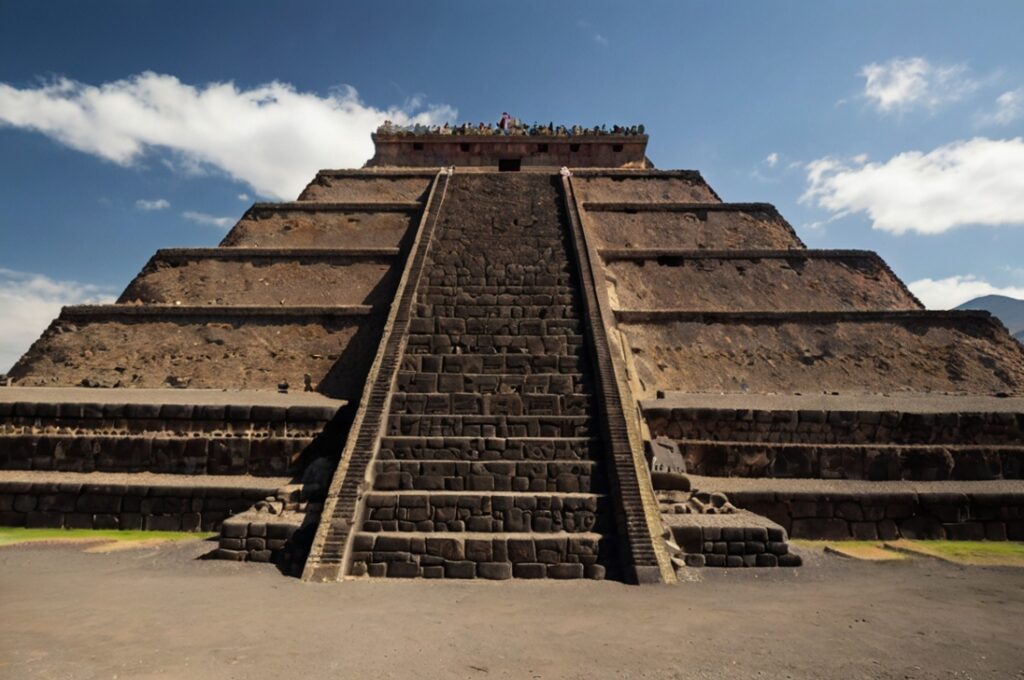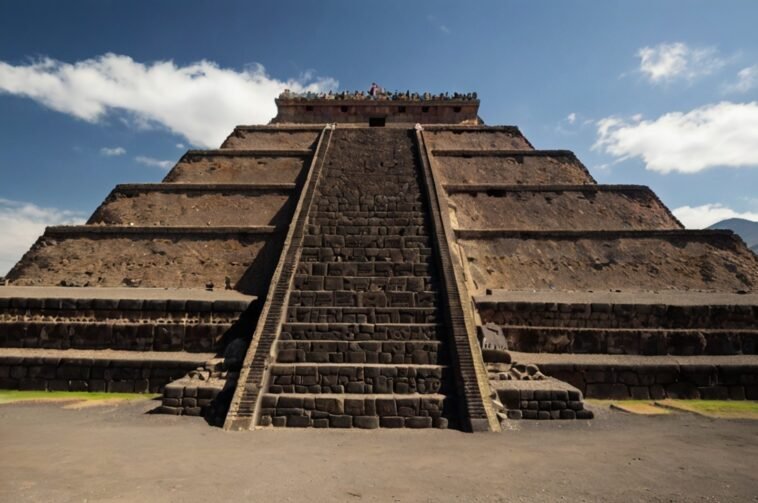
Teotihuacan, known as the “City of the Gods,” is one of the most fascinating ancient civilizations in the Americas.
Located about 30 miles northeast of modern-day Mexico City, this mysterious city thrived long before the Aztecs and was once a bustling urban center.
While the identity of its original builders and the reasons for its decline are still debated by scholars, there’s no doubt that Teotihuacan’s city planning, impressive architecture, and influence on Mesoamerican culture were significant.
The Rise of Teotihuacan
The rise of Teotihuacan began around 100 BCE, with its golden age occurring between 100 and 650 CE. At its height,
Teotihuacan was the largest city in the Americas, with an estimated population of over 125,000 people.
To put that into perspective, it was one of the largest cities in the world at that time, rivaling places like Rome and Constantinople.
One key factor in Teotihuacan’s growth was its strategic location in the Valley of Mexico, which provided access to vital trade routes and fertile land for agriculture.
The city’s leaders capitalized on these advantages, transforming Teotihuacan into a thriving economic and cultural hub.
The reasons for Teotihuacan’s rapid growth and why it attracted such a large population are still debated.
Some historians suggest that it was due to its role as a trade center, while others point to religious significance or the city’s ability to control surrounding regions politically.

Urban Planning and Architecture
Teotihuacan’s urban planning and architecture are among its most awe-inspiring features.
The city was meticulously planned and constructed with a grid layout, which is unusual for ancient civilizations.
At its core is the Avenue of the Dead, a massive thoroughfare stretching about 2.5 miles, flanked by temples, plazas, and pyramids.
The two most iconic structures are the Pyramid of the Sun and the Pyramid of the Moon.
The Pyramid of the Sun is the third-largest pyramid in the world, standing at about 216 feet tall.
These monumental structures were not only architectural feats but also likely served as religious and ceremonial centers.
What’s fascinating is the level of planning involved in the city’s construction.
Residential areas were divided into distinct neighborhoods, many of which housed specific craft workers or immigrants from other regions.
The city also included large apartment complexes, some of the earliest in the world, which housed a diverse population.
The construction of Teotihuacan reflects an advanced understanding of engineering and astronomy.
The city is aligned with astronomical phenomena, such as the setting sun on the equinoxes.
This alignment suggests that religion and cosmology were integral to its design.
Religion and Mythology
Religion played a central role in the life of Teotihuacan.
The city was not only a political and economic power but also a religious one, with temples and pyramids acting as focal points for worship and rituals.
The people of Teotihuacan believed in a pantheon of gods, many of whom would later influence the beliefs of other Mesoamerican civilizations, such as the Maya and Aztecs.
One of the most important deities was the Feathered Serpent or Quetzalcoatl, associated with creation, fertility, and wind.
The Temple of the Feathered Serpent is adorned with elaborate carvings and sculptures, reflecting the importance of this deity.
Human sacrifice was also practiced in Teotihuacan, particularly in connection with religious ceremonies.
Remains of sacrificial victims, often prisoners of war, have been found at various sites, including the Pyramid of the Moon.
These rituals were likely meant to appease the gods and ensure the city’s prosperity.

Daily Life and Economy
Teotihuacan’s economy was diverse, with agriculture forming the backbone of daily life.
The city’s fertile land and complex irrigation systems allowed for the cultivation of crops such as maize, beans, and squash. In addition to agriculture,
Teotihuacan was a major trade hub, engaging in extensive trade networks that stretched as far as present-day Guatemala.
The city’s artisans were highly skilled in producing pottery, obsidian tools, and intricate jewelry.
Obsidian, in particular, was a valuable resource, and Teotihuacan was one of the major producers of obsidian tools in Mesoamerica.
These goods were traded throughout the region, contributing to the city’s wealth.
Teotihuacan was also home to a wide range of professions, from farmers and artisans to merchants and priests.
The city’s economy was highly organized, and the distribution of goods and resources was tightly controlled by the ruling elite.
Social Structure and Governance
Teotihuacan had a highly stratified society, with a clear division between the elite ruling class and the common people.
At the top were the rulers and priests who held religious and political power.
Below them were the artisans, merchants, and farmers who formed the backbone of the city’s economy.
Governance in Teotihuacan remains a mystery.
Unlike the Maya or Aztec civilizations, no clear evidence of individual rulers, such as kings or queens, has been found.
Instead, some scholars propose that the city was governed by a council or collective leadership.
This theory is based on the absence of royal tombs or monuments glorifying individual rulers.
However, the social hierarchy was strict, and power was clearly centralized, as evidenced by the city’s organized infrastructure and large-scale construction projects.

Decline and Fall
Teotihuacan’s decline began around 600-650 CE, and by the 8th century, the city had been largely abandoned.
The reasons for its fall remain unclear, but several factors may have contributed to its collapse.
Internal conflict, possibly between different factions or classes, could have destabilized the city.
Additionally, environmental factors such as droughts or resource depletion may have played a role.
Archaeological evidence suggests that parts of the city, particularly elite compounds, were burned, which may indicate a violent revolt or invasion.
Although Teotihuacan was abandoned, its influence on Mesoamerican culture persisted.
The Aztecs, who arrived in the region centuries later, revered Teotihuacan as a sacred site and believed it to be the birthplace of the gods.
Final Thoughts
Teotihuacan remains one of the most enigmatic civilizations in history.
Its advanced urban planning, monumental architecture, and influence on later cultures have left an indelible mark on Mesoamerican history.
Despite the mystery surrounding its rise and fall, the city continues to fascinate scholars and visitors alike.
As archaeologists continue to uncover new evidence, we inch closer to understanding the secrets of this ancient metropolis, but much remains unknown.



